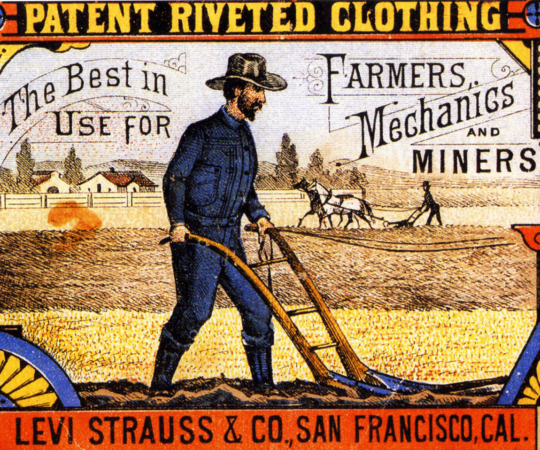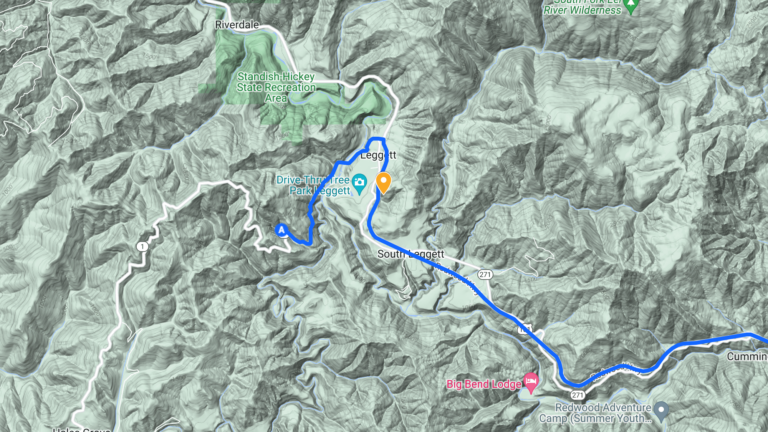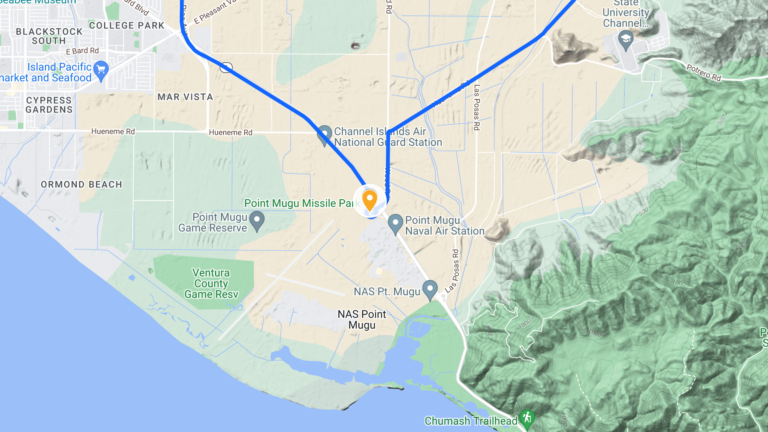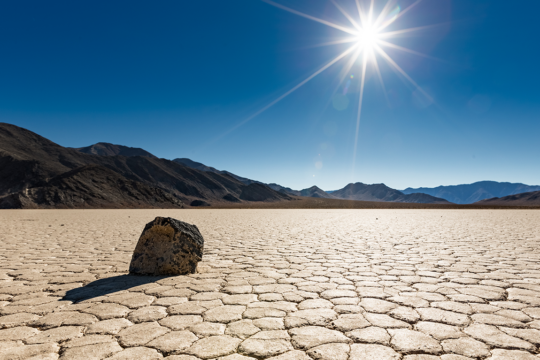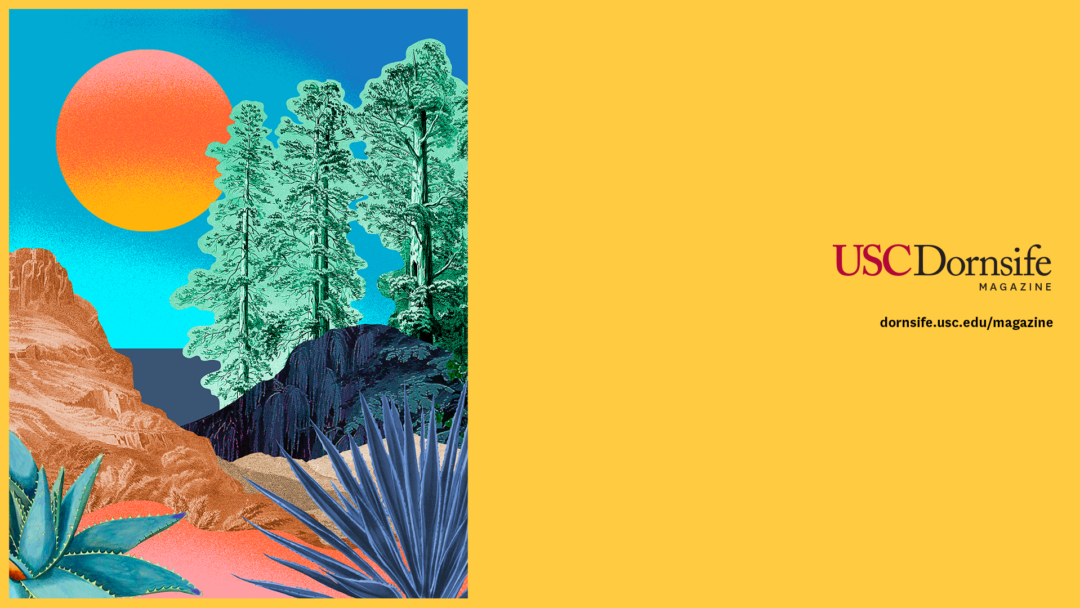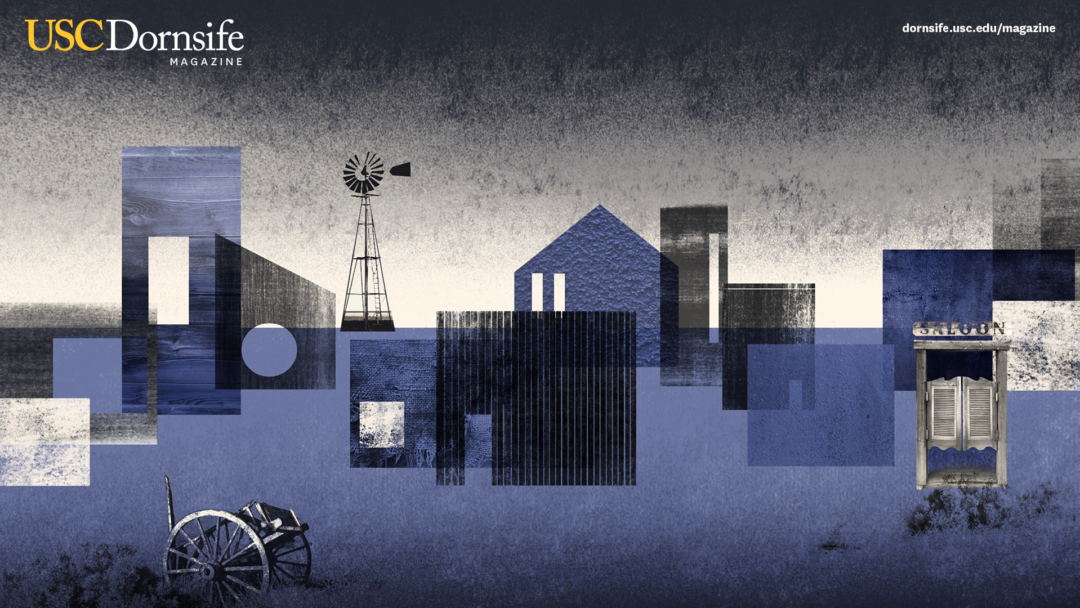California
The Golden State offers myriad stories, each revealing a new facet of its character. In this issue, we invite you to explore the deeper meaning behind California’s powerful association with beauty, learn how Indigenous knowledge handed down over thousands of years is helping our scholars tackle the growing threat of wildfire, discover forgotten nuggets of California history, muster your courage for an eerie journey through abandoned ghost towns, reflect on what makes California iconic, and take a road trip to some of the state’s quirkiest roadside attractions. We hope you enjoy the ride!
Susan Bell
Editor-in-Chief

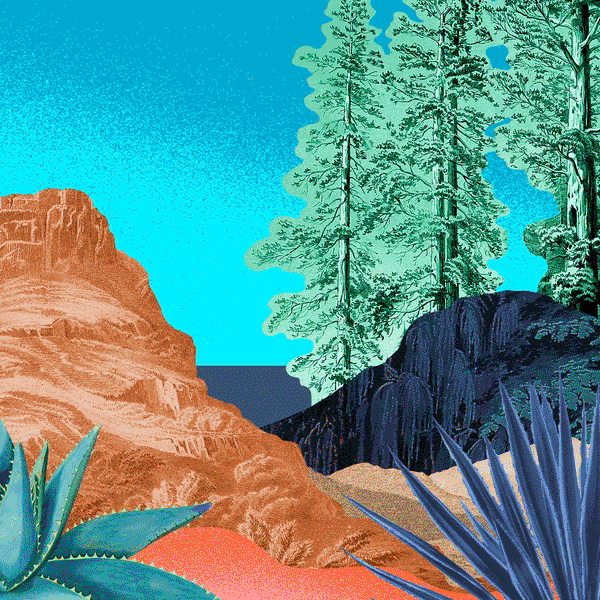
More Than Meets the Eye: Why California Has a Unique Relationship with Beauty
Understanding the state’s powerful association with beauty offers profound insights into its history, evolution and global reputation.

California Dreaming
Defining California may seem an impossible task, given the state’s immense size, its rich history and remarkable diversity. And yet, when we hear the phrase “California Dream,” we instinctively grasp its meaning.

The Books That Define California
“California writers benefit by their distance — both aesthetic and geographic — from the literary centers of the east.”

Echoes in the Dust: The Hidden History of California’s Ghost Towns
These abandonned communities may be haunting but they also still have much to teach us about the Golden State’s complex history.
Forgotten Nuggets of California History
California’s rich history is often defined by iconic periods such as the Gold Rush, the rise of Hollywood, and the aerospace boom. But beneath these celebrated events lie lesser-known stories that have quietly shaped the state’s identity.
By Marcus Paulsen
“From audacious bids for independence to cultural innovations and covert wartime plots, exploring these forgotten chapters offers a deeper understanding of the remarkable forces of innovation, creativity, courage and persistence that helped define the Golden State.”
William Deverell, divisional dean of social sciences and co-director of the Huntington-USC Institute on California and the West.
California’s Brief Republic, Its Enduring Flag (and our cover)
In June 1846, at the outset of the Mexican-American War, some 30 American settlers seized the Mexican-administered town of Sonoma, north of San Francisco. Declaring independence, they raised a makeshift flag featuring a crudely drawn bear. Though the California Republic lasted only 25 days, its flag endured, ultimately becoming the inspiration for the official state flag adopted in 1911. The bear featured on the official flag was modeled after “Monarch,” a California grizzly captured in Ventura County in 1889 on the orders of newspaper tycoon William Randolph Hearst, and held captive in San Francisco for 22 years. Featuring the California flag’s grizzly, our cover is inspired by the 1913 sheet music cover of the state song, “I Love You, California.”
(Photo: Wikimedia Commons.)

Foiling Fascism in California
In July 1933, just months after Adolf Hitler rose to power, Nazi-aligned supporters held their first public meeting in L.A. This sinister gathering —replete with brown shirts, swastikas and Nazi salutes — evolved into a movement that aimed to seize Southern California armories and murder influential Hollywood producers and actors. “The movement was stymied by a group of citizen-spies, led by Jewish attorney Leon Lewis, who thwarted their plots against democracy,” says Distinguished Professor Steve Ross, Dean’s Professor of History and an expert on the period. Ultimately, local Nazi sympathies dwindled as the nation united against fascism following the Japanese attack on Pearl Harbor.
(Photo: Alamy.)

Pioneering Woman Botanist Championed the Golden Poppy
A symbol of California’s beauty, the golden poppy became the state flower thanks to the persistence of botanist Sara Plummer Lemmon. A specialist in Western flora, Lemmon discovered 110 plant species and tirelessly worked with the legislature to introduce bills recognizing the golden poppy. After nearly a decade of advocacy, and overcoming opposition from two governors, the bill was finally signed into law in 1903. “Lemmon’s work reveals the interwoven strands of scientific wild-botanizing, women’s club culture, and efforts to craft the mythology of California during the era,” says Elizabeth Logan, co-director of the Huntington–USC Institute on California and the West
(Photo: Wikimedia Commons.)

The Birth of Blue Jeans: A California Legacy
While California is the birthplace of many iconic cultural exports, one stands out as having legs: good ol’ blue jeans. Patented in 1873 by business partners Levi Strauss and Jacob Davis, the denim pants reinforced with metal rivets were manufactured in San Francisco. They were originally designed for laborers who needed more durable clothing to withstand the rigors of mining, ranching and farming in the American West.
(Photo: Alamy.)

From Humble Stage to Legendary Venue
When the Hollywood Bowl opened on July 11, 1922, it was little more than a wooden platform with a canvas top. Over time, it grew into a legendary music venue, considered the largest natural outdoor amphitheater in the United States. The Bowl has hosted some of the most influential performances of the 20th century, from the Beatles’ 1964 Los Angeles debut to the Doors’ 1968 concert, released as a live album in 1987.
(Photo: Wikimedia Commons.)

A State Divided: Southern California’s Bid for Slavery
In 1850, California joined the Union as a free state. But by 1858, many Southern California ranch owners pushed for the region to become a separate territory where slavery would be permitted. State Sen. Andrés Pico led the movement, and the California State Assembly passed a proposal to split the state at the 36th parallel, creating the “Territory of Colorado” from the southern counties. “This proposal was one of the earliest — and perhaps the most ignominious — of about 220 attempts to divide California,” says Alice Baumgartner, associate professor of history. Ultimately, the proposal never reached the U.S. Congress due to the outbreak of the American Civil War.
(Photo: Wikimedia Commons.)

California’s Vagabond Capital
Sacramento is now California’s established seat of political power, but in the state’s early years, its capital was surprisingly nomadic. Between 1849 and 1862, the capital moved frequently — from Monterey to San Jose, then to Vallejo, Benicia, and finally, Sacramento, chosen for its river network and proximity to the Gold Rush. However, flooding in 1862 temporarily forced the capital to relocate to San Francisco. The legislature returned to Sacramento and state officials settled permanently in the Capitol building in 1869, even though it was still under construction.
(Photo: Wikimedia Commons.)
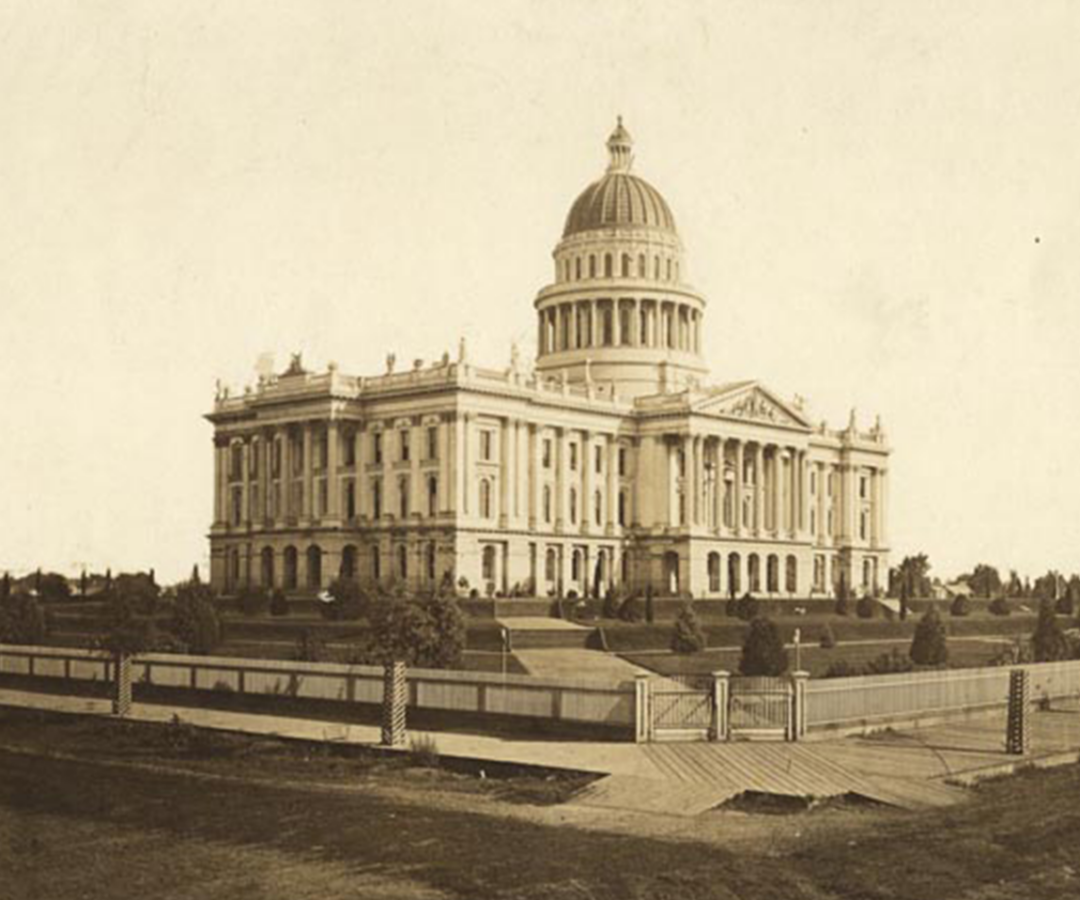

Perilous Paradise: How Ancient Native Wisdom Could Help California Manage Its Wildfires
For centuries, Indigenous tribes managed California’s volatility. Today, their ancestral knowledge is more vital than ever.
FEATUREOn the Road: The Best of California’s Roadside Attractions

She’s Got You Covered: Meet the Professor Working to Improve California’s Fire Insurance Industry
Monalisa Chatterjee has spent her career studying how humans adapt to extreme climate events such as tropical cyclones, urban floods and droughts. In recent years, the associate professor and graduate director of environmental studies has turned her focus to a climate trend that’s especially urgent in California: wildfires.
California: Utopia or Dystopia?
A historian debates the issue with a professor of American studies and ethnicity.
“California’s future is a canvas painted in utopian hues.”
– Elizabeth Logan
“California has always had a dystopian edge.”
– Juan De Lara

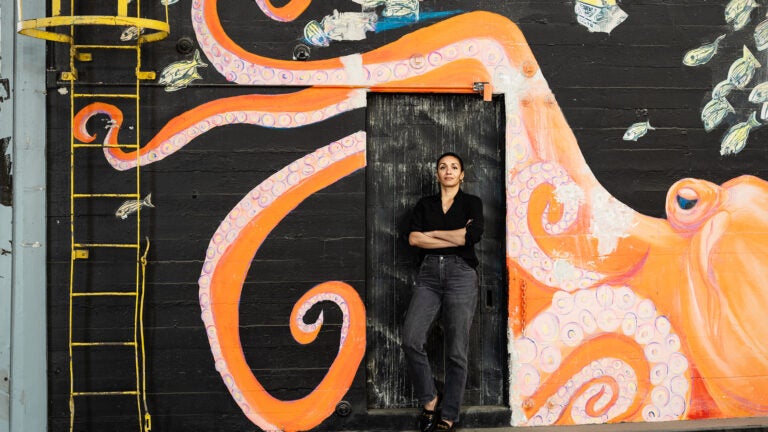
Who Is Jade Clemons and How Is She Boosting California’s “Blue Economy”?
As director of the Blue Sustainable Economy Alliance — “BlueSEA” — at AltaSea, a nonprofit at the Port of Los Angeles, Jade Clemons ’19 is helping to steer a more equitable and sustainable future for California’s environment — and, perhaps unexpectedly, for its people, too.
Rock Star Virologist: The Offspring’s Dexter Holland, The Punk Rocker With a PhD

Dexter Holland ’88, ’90, ’17, is the frontman and songwriter of The Offspring, one of the world’s best-selling punk rock bands. Holland earned three degrees — including a PhD in molecular biology — from USC Dornsife, has flown solo around the world, and created an award-winning brand of hot sauce. Oh, and he collects postage stamps from the Isle of Man. (Illustrations: Carmen Segovia.)
Dexter Holland’s Path
As valedictorian of his Garden Grove, California, high school, Brian Keith “Dexter” Holland had ambitions to go to medical school.
As valedictorian of his Garden Grove, California, high school, Brian Keith “Dexter” Holland had ambitions to go to medical school. He enrolled at USC Dornsife as a biological sciences major in 1984 — the same year he and high school friends launched a punk rock garage band called Manic Subsidal. None could yet play a musical instrument.
As the group evolved into what would become The Offspring, Holland pursued his education
As the group evolved into what would become The Offspring, Holland pursued his education, earning his bachelor’s degree in biological sciences in 1988 and a master’s in molecular biology in 1990. He then embarked on his doctorate; however, the stunning breakthrough of the band’s 1994 album, Smash, persuaded him to put his degree on hold. Says Holland: “Molecular biology and music may seem like polar opposites, but they overlap through math and pattern recognition.” His science background even inspired the famous refrain “Keep ’em separated” from the band’s hit song “Come Out and Play” — a line that drew on his experience cooling Erlenmeyer flasks of hot liquid in a USC Dornsife lab.
A licensed pilot and certified flight instructor
A licensed pilot and certified flight instructor, Holland completed a 2004 solo flight around-the-world in his twin-engine Cessna Citation, covering 25,000 miles in 10 days. He often flies his band to and from performances and, in his free time, volunteers as a medical transport pilot.
Holland launched his own hot sauce brand, Gringo Bandito
After two years of taste-testing different spice and pepper combinations in his kitchen, Holland launched his own hot sauce brand, Gringo Bandito, in 2004, describing his fiery concoctions as “a party in your mouth.”
Holland paused his music career
Holland paused his music career in 2012 to return to his doctoral studies at USC Dornsife, earning his PhD in 2017. Five years later, he delivered the commencement address at Keck School of Medicine of USC.
Holland performed with legendary guitarist Sir Brian May of Queen
In May 2024, legendary guitarist and fellow PhD Sir Brian May of Queen joined Holland to perform The Offspring’s hit “Gone Away” at the Starmus Festival in Slovakia. The Offspring’s 10th studio album, Supercharged, followed in October, with its single “Make It All Right” becoming the band’s first to simultaneously top Billboard’s Rock and Alternative Airplay Chart and Mediabase’s Active Rock Chart. The Offspring has now sold more than 40 million records, making it one of the world’s best-selling punk rock bands. Following a 2025 international tour of 100 cities, Holland plans to continue making music and hopes to use his molecular biology training to contribute to HIV research.
Geology Rocks: Discover California’s Unique Geological Formations
California’s landscape is shaped by millions of years of dynamic geological forces — from tectonic shifts and volcanic eruptions to changing sea levels and relentless erosion. This intense activity has created one of the most complex and diverse geologies in the world.
By Daniel P. Smith
“It’s astounding how much California offers from a geological perspective. Tectonic environments, rich mineral deposits, evidence of glacial activity, and some of the most significant fossils in North America, make this state a geologic treasure trove like no other.”
Frank Corsetti chair and professor of Earth sciences
Peaks And Troughs
California is home to both the highest and lowest elevations in the contiguous United States — and they’re practically neighbors. Just 80 miles apart, Mt. Whitney rises to 14,505 feet as the tallest mountain peak in the continental U.S., while Death Valley plunges 282 feet below sea level, making it the lowest elevation on the mainland.
(Photo: Wikimedia Commons.)

The Irony of “Snowball Earth”
Earth scientists studying Death Valley’s rocks have uncovered evidence
of the most extreme ice age of all time, known as “Snowball Earth,” which occurred approximately 700 million years ago. The irony? They’re researching the coldest period in our planet’s history in what is now the hottest place on Earth.
(Photo: iStock.)

Shake, Rattle and Roll
California is riddled with fault lines, making it one of the world’s most earthquake-prone regions. The San Andreas Fault, which runs 800 miles (nearly the length of the state), is the most infamous. While most of the thousands of small quakes that occur in California each year are too subtle for humans to feel, they offer scientists valuable insights. “These small earthquakes provide highly detailed information about the faults’ subsurface geometry, helping us map tectonic activity and assess seismic hazards,” says Yehuda Ben-Zion, professor of Earth sciences and director of the Statewide California Earthquake Center, based at USC Dornsife.
(Photo: Wikimedia Commons.)

Fossil Heaven
Sedimentary rocks near Barstow in Southern California’s Mojave Desert hold one of the world’s densest concentrations of fossils from creatures like camels, pygmy running rhinos, and saber-toothed cats that roamed the Earth 13 million to 16 million years ago. Remarkably, fossils of at least 17 species found here have never been discovered anywhere else. The area is so fossil-rich that scientists named a geologic time period after it: the Barstovian North American Stage.
(Photo: Wikimedia Commons.)

Cruel Twist
California is often hailed as a leader in the green economy, but here’s the irony: To power clean energy and advance green technology, the state relies on rare Earth elements that are abundant in San Bernardino County’s Mountain Pass mine. This site has the highest concentration of these valuable materials in the Western Hemisphere, and their extraction requires mining — an activity that can conflict with environmental goals.
(Photo: Wikimedia Commons.)

Future Neighbors?
San Francisco and Los Angeles are nearly 400 miles apart today, but in as little as
10 million years, they could be neighbors. San Francisco sits on the east side of the San Andreas Fault, while L.A. lies on the west. As the side to the west creeps northward, it is slowly dragging the City of Angels with it.
(Photo: iStock.)

USC Dornsife Magazine Creative Writing Contest
Congratulations to the winner of the USC Dornsife Magazine Creative Writing Contest – Sophia Hammerle, a senior majoring in narrative studies and gender and sexuality studies.
The contest, open to USC Dornsife alumni and students, attracted entries across a diverse range of majors. The brief was to write a maximum of 500 words inspired by the theme of this issue, “California,” in any of the following genres: fiction, poetry, memoir or essay.

We Could Help Prevent Homelessness
USC Dornsife’s Public Exchange (PX) leads a partnership with the self-storage industry that has the potential to prevent people from becoming unhoused.

Share Your News
Calling USC Dornsife alumni — USC Dornsife Magazine wants to hear about your latest professional achievements. Just fill out a short form to share your news with us.
Contact Us
USC Dornsife Magazine
c/o Crisann Smith
1150 S. Olive St
SCT-2400
Los Angeles, CA 90015
Editor-in-Chief
Susan Bell
Creative Director
Letty Avila
Senior Associate Dean for Communication and Marketing
Jim Key
Writers and Editors
Margaret Crable
Darrin S. Joy
Multimedia News Director
Katie Kim Scott
Media Relations Director
Ileana Wachtel
Videographer and Photographer
Mike Glier
Senior Web Specialist
Michael Liu
Audience Engagement Editor
Christelle Snow
Administrative Assistant
Crisann Smith
Contributors
Jai Battle, Olga Burymska, Stephen Koenig, Rachel B. Levin, Kelly Lukito, Markos Mendez, Marcus Paulsen, Vanessa Roveto, Daniel P. Smith, David L. Ulin, Tomas Weber
USC Dornsife Magazine is published twice a year by the USC Dornsife Office of Communication at the University of Southern California and is distributed to alumni, faculty, staff, parents and friends of USC Dornsife College of Letters, Arts and Sciences.




